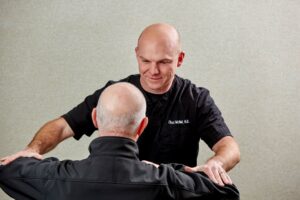
Everything You Need to Know About Torn Rotator Cuffs
A rotator cuff tear is a disruption of 1 of the tendons that attach is to the humeral head from the shoulder blade. There total of 4 tendons that comprise the rotator cuff: 1 internal rotator, the subscapularis, 1 superior muscle tendon unit, the supraspinatus and 2 external rotators, the infraspinatus and teres minor. Most frequently, the tendon is torn from the bone but occasionally there will be muscular tendinous ruptures.
Symptoms include pain and weakness predominantly. Sometimes this is associated with stiffness.
Rotator cuff tear frequency increases with age. The higher incidence of tears occurs after 60 years of age. It is more common to have asymptomatic tears in older individuals and subsequently more of those can be treated with conservative management.
Depending on the tear type, the treatment options will very. In a younger patient with an acute rotator cuff tear, surgical intervention with an arthroscopic rotator cuff repair is the best treatment. With older patients and chronic tears, a trial of conservative management comprised of nonsteroidal anti-inflammatories and physical therapy to strengthen the remaining rotator cuff muscles and the deltoid is often times successful.
 If the conservative management of time, medication and physical therapy does not restore strength and range of motion, surgical intervention is warranted in the setting of chronic rotator cuff tears. There are circumstances when patient is present with repeat tears or very large chronic rotator cuff tears that are beyond repair. If these patients do not have any arthritic change in the shoulder, they will be candidates for tendon transfers. If arthritic changes present, a reverse shoulder arthroplasty may be the only remaining option.
If the conservative management of time, medication and physical therapy does not restore strength and range of motion, surgical intervention is warranted in the setting of chronic rotator cuff tears. There are circumstances when patient is present with repeat tears or very large chronic rotator cuff tears that are beyond repair. If these patients do not have any arthritic change in the shoulder, they will be candidates for tendon transfers. If arthritic changes present, a reverse shoulder arthroplasty may be the only remaining option.
 A majority of these surgeries can be done on an outpatient basis, even shoulder replacement. Healing time is independent upon the size of the rotator cuff tear, but smaller tears have a higher healing rate overall. It takes about 3 months for the tendon to be 50 percent healed in about 6 months for the tendon to be 80 percent healed. I typically will start physical therapy 5 or 6 weeks after surgery but will delay any strengthening until 4 months after surgery to give the tendon appropriate amount of time to start the healing process. Healing rates depend on multiple factors, some within the surgeon's control and some out of the surgeon’s control. Obviously, surgical technique including appropriate tensioning of the rotator cuff tendon and appropriate attachment points significantly improved the healing rate. The biggest factor in my practice that dictates whether not a patient heals is the patient has nicotine status. Patient is that smoke, dip or use some other source of nicotine have a significantly higher rate of failure in rotator cuff repair. Acute rotator cuff tears also have a higher likelihood of healing as compared to chronic retracted rotator cuff tears.
A majority of these surgeries can be done on an outpatient basis, even shoulder replacement. Healing time is independent upon the size of the rotator cuff tear, but smaller tears have a higher healing rate overall. It takes about 3 months for the tendon to be 50 percent healed in about 6 months for the tendon to be 80 percent healed. I typically will start physical therapy 5 or 6 weeks after surgery but will delay any strengthening until 4 months after surgery to give the tendon appropriate amount of time to start the healing process. Healing rates depend on multiple factors, some within the surgeon's control and some out of the surgeon’s control. Obviously, surgical technique including appropriate tensioning of the rotator cuff tendon and appropriate attachment points significantly improved the healing rate. The biggest factor in my practice that dictates whether not a patient heals is the patient has nicotine status. Patient is that smoke, dip or use some other source of nicotine have a significantly higher rate of failure in rotator cuff repair. Acute rotator cuff tears also have a higher likelihood of healing as compared to chronic retracted rotator cuff tears.
Azalea Orthopedics is the authority in treating a wide-variety of shoulder conditions in East Texas. Our shoulder specialists are board-certified and fellowship trained to provide the best outcomes possible. Azalea Orthopedics' shoulder doctors are in Athens, Longview, Mount Pleasant, Palestine and Tyler. Click here to find a shoulder specialists near you. We are here to serve you. Please call 903-939-7501 or click here to schedule an appointment with one of our specialists today!


